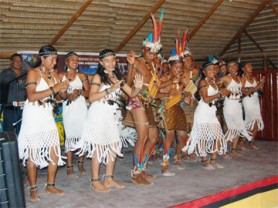Dorothy Faria dances. She then instructs interested hopefuls to replicate what they would have seen. From their performances, she decides which ones are malleable material; and assesses the least shy. These she picks to be members of Katiwau.
Katiwau (Sand Creek) is the name of a Wapishana cultural troupe, which Dorothy leads. Passionate about her culture, Dorothy teaches young people in her village various forms of their culture so they could be proud of their ancestry and able to pass it on to others in the future.
“We must not be ashamed of our culture. We should show the world we are proud and will always be,” she said. In the case of the young people of Sand Creek, South Central Rupununi, Dorothy does not believe they are ashamed of their culture per se. “Many want to be part of the group,” she explained, “but they get stage fright.”
Dorothy, who was once a teacher, told The Scene said that she loves working with young people and sees them as means of transmitting Indigenous culture, which, she said, is slowly slipping away. While, the youth are members of the culture group, being in their presence, makes one realise that they have bonded as a family.
During her interview with The Scene, Dorothy is surrounded by several of the young members of the group who listen as she recounts how she began to teach dances, songs and skits in Sand Creek.
In 1995, when the idea of having a month designated for Amerindian
Heritage was put forward, Dorothy was interested and sought to find a way to make a contribution. However, she was unsure of the organization of the celebration and decided to observe; which she did for several years.
Finally, in 1999, she realised that her contribution would be in getting young people to learn dances, songs and poems which they could perform during heritage month celebrations. The group was named Katiwau, which means ‘Sand Creek’ in Wapishana. Dorothy said she wanted the group’s name to reflect the heritage.

The initial group she had worked with attended the Regional Heritage Celebrations and was lauded for its performance. Based on the feedback, she realised that they group had great potential and since then Katiwau has performed at various heritage month celebrations in the region as well as in Georgetown. The group has also performed at Carifesta celebrations held
in Suriname and Guyana.
Its performance was part of the cultural extravaganza held at the Amerindian Village, Sophia. Dorothy said she was very proud of her group which has 16 members between the ages of 11 and 16.
She said she spends a lot of time with these young people, who frequent her home to practice. In addition to being taught the art forms, they are also taught how to put together their costumes.
Making the costumes is hard work and requires the help of several other persons for the pain-staking task of pasting and sewing beads and feathers to assemble unique pieces. She said she looks back at costumes she had made in earlier years as compared to those made now, and see much improvement in them.
The group performs dances which are traditional to the Wapishana peoples like the Parashara and Mari-Mari. Though the names are similar to dances of other nations, Dorothy noted that there are differences in the steps.
Commenting on Wapishana culture, she said that much of it is still intact, but there are parts which have begun to slip away. The communities have been able to maintain their staple diets of farine, cassava bread and be engaged in activities such as hunting, fishing and farming.
Amerindian spirituality remains very much unshaken and Dorothy said she believes in the healing power of the Piaiman. She said the elders of the village are the holders of knowledge about herbal medicine. Further, the connectivity of Amerindians with their environment is very much still alive. She gave as an example the fact that the position of the moon and certain stars which tell a person when to plant crops.
“Youths today are rebellious. They only believe in nonsense,” Dorothy said, “I am proud of my culture; that is why I do this.” She believes that if youths listened to their elders and availed themselves of the knowledge, then their culture would still be there.
Language is the main area identified as being greatly threatened. Dorothy said that when she speaks to members of Katiwau in Wapishana, they often look at each other and giggle. This inability to understand and speak their language, she opined comes from parents’ not teaching their children the language.
Dorothy is not only the group’s teacher but a second mother. Apart from her teachings on culture, she also gives them moral talks, teaches them to cook and about table etiquette. One of her most important teachings is instilling in them the importance to believe in themselves.
“Culture makes me happy. This is my passion,” she said. Members of Katiwau would do well to not only learn from, but to emulate Dorothy.

